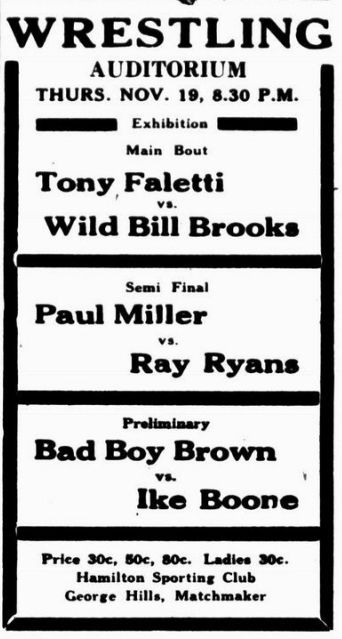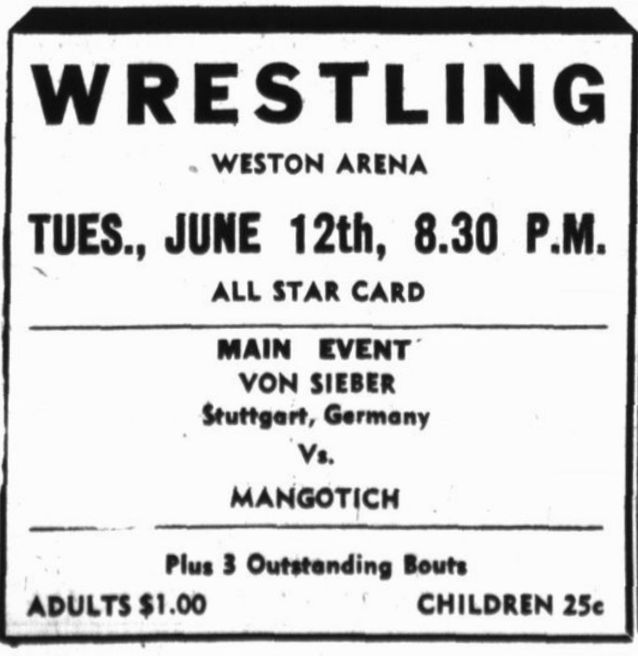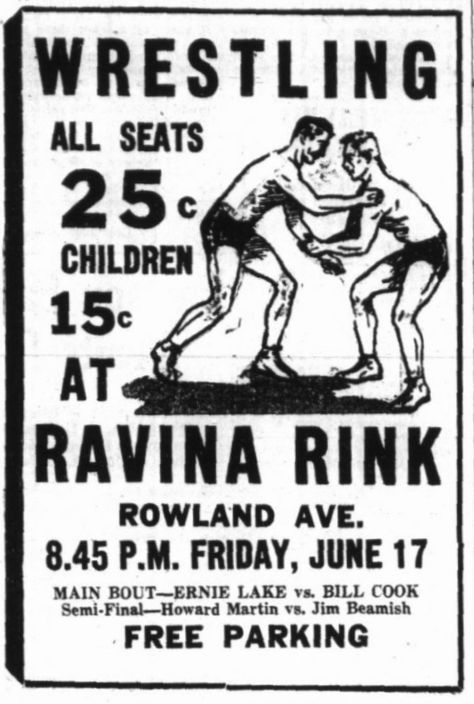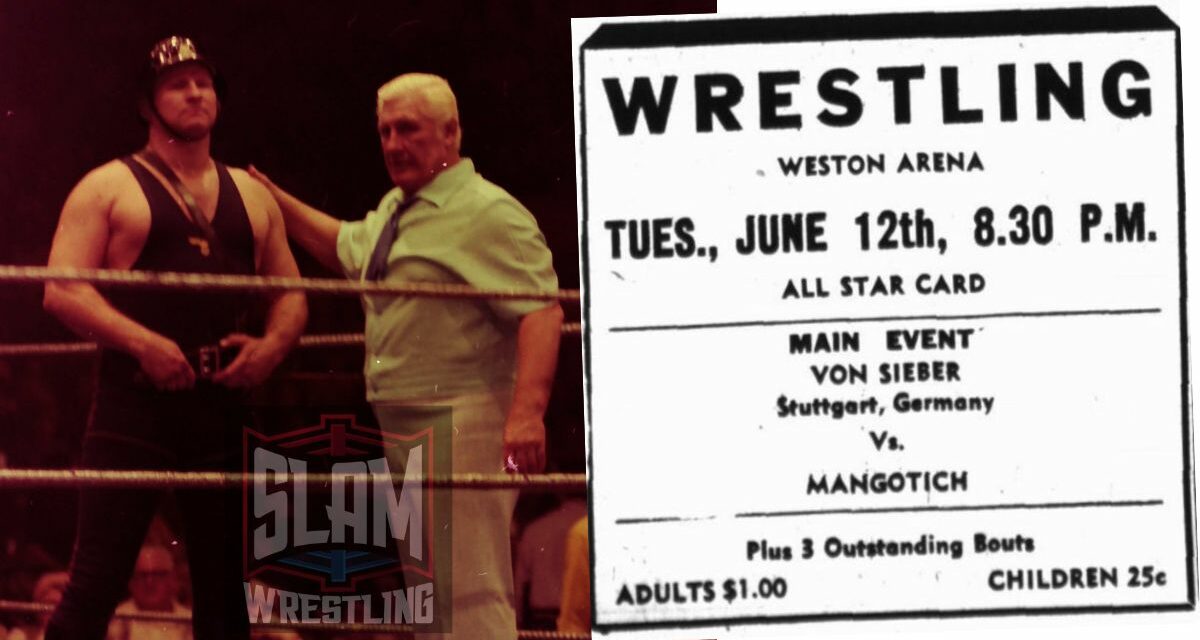Historians can be a smug bunch. It doesn’t really matter the subject, but if someone has spent a lifetime studying and learning about a topic, there’s a natural tendency to crow a bit, to show off what you know.
I’m guilty of it, for sure, and I know “humble” isn’t a word thrown around about me. Heh, heh.
But here I am, having spent a couple of months doing a deep dive into small-town Ontario results, and I have come away from the experience humbled, and every other synonym for it too: bewildered, chagrined, confounded, confused, discombobulated, disconcerted, fuddled, humiliated, shamed, in a tizzy, taken aback.
A simple example.
I grew up in Kitchener, Ontario, about an hour from Toronto. Eventually, I got around to trying to go through the results for Kitchener-Waterloo, and on my very first one that I started to work on, I was absolutely stumped. I didn’t recognize a single name: Tony Faletti vs Wild Bill Brooks; Paul Miller vs Ray Ryans; Bad Boy Brown vs Ike Boone.
The card is from Thursday, November 19, 1936, and the show was at the Kitchener Auditorium, which was at the corner of Queen and Charles Streets, and is generally now referred to as the Queen Street Auditorium, since “The Aud” — the home of the OHL’s Kitchener Rangers — opened in 1951 and is officially the Kitchener Memorial Auditorium.

A show from Kitchener, Ontario, on Thursday, November 19, 1936.
It’s like the Waterloo Chronicle newspaper was mocking me, too, as in its short preview for the show, noted on Ike Boone, “who we don’t know much about” and that Ray Ryans is a “new-comer to the local arena.” And it vouched for the main eventers, swearing that Faletti and Brooks “always put on a good show.”
This has not been an isolated incident.
For every neat discovery, like Bill Potts on a 1935 card, when our previously-noted first appearance of the future Whipper Billy Watson was 1936, or the burgeoning careers of Baron Waldo Von Seiber — the future Waldo Von Erich — or Mike Valentino, who’d become Baron Mikel Scicluna, there were hundreds of names I knew next to nothing about.
To my chagrin, that’s unlikely to change.
These smaller town shows, from the 1930s to the early 1960s, often involved a ton of local talent, and there just will never be enough information on them. It’s a classic case of knowing then what I knew now. It turned out that I met many of these men — and it was all men back then, since women weren’t allowed to wrestle in Ontario — along the way, but dismissed them a little out of hand. I’d ask a bit about their careers, but never go in depth. And I certainly had never taken the time to do the research on these kind of small-town shows. (I’ll cut myself a little slack there, as it’s become so much easier to research through the years.)
I got to know “Uncle Waldo” through the years, but whenever we talked, I focused on his stardom, headlining Madison Square Garden, not working the Thornhill Market, beating Calvin Cosbun in two out of the three falls in April 1956.

We’ve come to understand there were a plethora of “Masked Marvels” and other such generic names through the years, but does Impact Wrestling’s Eddie Edwards know that there was an Eddie Edwards in the 1950s working small towns in Ontario?
Ed “Gori” Mangotich became a decent star in England, but in Ontario, he headlined too, just not at Maple Leaf Gardens. His brother, Doni, was a pretty good hand as well.
Speaking of MLG, we all know how ridiculous it was having the portly Al “Bunny” Dunlop as the referee in the 1960s and ’70s, slower than molasses and prone to stick his nose into the action. But there he is on top of the card, fit and healthy (though still big), in 1933.
Heck, I’m writing this as my son is umpiring a baseball game at Ravina Park in Toronto … where I found a card from 1938!

Friday, June 17, 1938 Weston, Ontario
There are plenty of similarities between the oodles of indies today and the small shows back then.
Albert Lepic was a local police officer on the card in Timmins in 1936. Well, Nova is a woman wrestler here in Ontario and fits in her appearances (including as manager/second Nova Cain in Demand Lucha) when she isn’t Andrea Benoit, a member of the Barrie Police Service.
Or the 1950s tag team of the Hamilton Hoods (Jack Diamond and Alex Jensen) would have worked as a name for, say, Hamiltonians Ethan Page and Rip Impact.
Even as we move into more recent times, like the 1970s, where Phil Watson is running shows — at least I think they are his shows, I never asked him about these small-time shows in Port Perry or wherever, with Whipper Watson Jr. in the main event — I get stumped. Who the heck was the “Arab Terrorist” he faced in Markham on May 15, 1973? I think it was Fazil Singh, who was often only listed as “Singh” on the advertisements, to intentionally confuse fans into thinking he’s Tiger Jeet Singh. For that matter, on the same show, who were the Masked Maulers? The “Mighty Humphrey” isn’t Happy Humphrey, but a knock-off years after the more famous one.
On top of the not knowing, there’s the not being able to share with people I know would have appreciated my finds. There are general historians, like the incomparable J Michael Kenyon and Don Luce, but also people who had very specific niches. Joe Pottgeiser would have been tickled to read about Johnny Swenski in 1936, and all the stuff I have found on the Kasaboskis outside of northern Ontario where Larry promoter would have made Gary Howard‘s day.
There’s a feeling of beating my head against a wall, knowing I’ll never crack through, never learn everything, never crack all the codes.
But man, it’s fun trying.
TOP PHOTO: Waldo Von Erich during his headlining days in the WWWF with manager Freddie Blassie. Photo by John Arezzi.
RELATED LINKS

